Butana and Kenana breeds are part of the shorthorned Zebu group of breeds of eastern Africa. What makes them unusual is that they are dairy breeds, unlike other breeds like the Boran, Baggara, Fung, etc. The Butana breed is found to the east of Khartoum in central Sudan, in the Butana region. The Atbarah Research Station of the Sudanese Department of Agriculture in Atbarah has a special mission for preserving and improving the Butana breed. The Kenana breed is found just south of Butana, mainly in the region between the Blue Nile and the White Nile.
The Butana cattle are a deep red color, like the Red Sindhi and Sahiwal of Pakistan. While somewhat smaller than the Sahiwal, the Butana is almost impossible to distinguish from the Red Sindhi. It is probable that the ancestral stock of the Red Sindhi was a principal component of the Zebu cattle brought from medieval India to Sudan over a thousand years ago to form the basis of the Butana breed, but that they are so identical after all this time is very surprising. The Kenana cattle are probably derived from the Butana, they are the same deep red as calves, but turn white when they are adults. The size, shape and milk production of both the Butana and the Kenana are almost identical to the Red Sindhi. This means they are by far the best dairy breeds in Africa, and tied for second place with the Red Sindhi after the Sahiwal as the best dairy breeds among all the Zebu breeds in the world.

The geography of Egypt relates to two regions: North Africa and West Asia.

Sudan is located in Northeast Africa. It is bordered by Egypt to the north, the Red Sea to the northeast, Eritrea and Ethiopia to the east, South Sudan to the south, the Central African Republic to the southwest, Chad to the west and Libya to the northwest. Sudan is the third largest country in Africa, after Algeria and the Democratic Republic of the Congo. It had been the largest country on the continent until the 2011 independence of South Sudan.

The zebu, sometimes known in the plural as indicine cattle, Camel cow or humped cattle, is a species or subspecies of domestic cattle originating in South Asia. Zebu, like many Sanga cattle breeds, differs from taurine cattle by a fatty hump on their shoulders, a large dewlap, and sometimes drooping ears. They are well adapted to withstanding high temperatures and are farmed throughout the tropics.
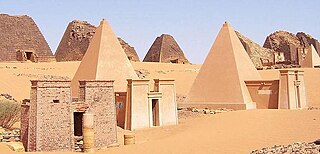
Meroë was an ancient city on the east bank of the Nile about 6 km north-east of the Kabushiya station near Shendi, Sudan, approximately 200 km north-east of Khartoum. Near the site is a group of villages called Bagrawiyah. This city was the capital of the Kingdom of Kush for several centuries from around 590 BC, until its collapse in the 4th century AD. The Kushitic Kingdom of Meroë gave its name to the "Island of Meroë", which was the modern region of Butana, a region bounded by the Nile, the Atbarah and the Blue Nile.

Sahiwal District, formerly known as Montgomery district, is a district in the Punjab province of Pakistan.
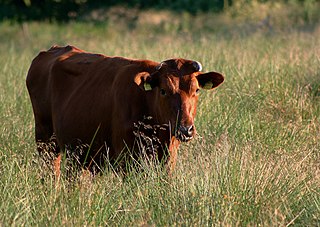
Danish Red cattle, also known as Red Danish or Red Dane, are a major dairy cattle breed in northern Europe. There are 42,599 pedigree cows in Denmark. They can be used as a beef breed once they finish their useful lifetime.

The Butana, historically called the Island of Meroë, is the region between the Atbara and the Nile in the Sudan. South of Khartoum it is bordered by the Blue Nile and in the east by Lake Tana in Ethiopia. It should not be confused with the Gezira, the region west of the Blue Nile and east of the White Nile.

The Red Sindhi is a dairy breed of zebuine cattle. It is believed to originate in western Sindh and in the Las Bela area of Balochistan, now in Pakistan. It is widely kept in Pakistan, where in 2006 there were approximately 3000000 head; there are small numbers in India and in Bangladesh. Other names include Las Bela, Malir and Sindhi.
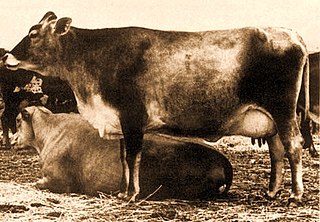
The Australian Milking Zebu (AMZ) is a composite breed of dairy cattle, developed by the Commonwealth Scientific and Industrial Research Organisation (CSIRO) in Australia during the mid-1950s. To develop the breed, the CSIRO bred Sahiwal and Red Sindhi cattle from Pakistan with Jersey cattle. Some Illawarra, Guernsey and Friesian genetics were also included. The development of the breed was governed by strict selection for heat tolerance, milk production and cattle tick resistance to result in the modern AMZ breed.
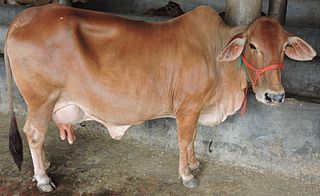
Sahiwal cattle is a breed of Indian zebu cow, named after the Sahiwal district of modern-day Pakistan.. The cattle is mainly found in Punjab province of Pakistan, and Indian states of Punjab, Haryana, & Rajasthan.
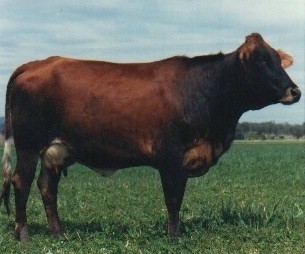
The Australian Friesian Sahiwal, is an Australian breed of dairy cattle whose development commenced in the 1960s by the Queensland Government. It is a combination of the Sahiwal, a dairy breed of Bos indicus from Pakistan and Holstein breeds, designed for the tropical regions of Australia. Cows produce approximately 3,000 litres of milk per lactation under tropical pasture conditions with a high resistance to heat, humidity, ticks and other parasites.
Baggara cattle are an autochthonous Sudanese breed part of the shorthorned Zebu group of breeds of eastern Africa. Baggara cattle are smaller and thinner than the Boran breed of Kenya and Ethiopia. They are named for the Baggara people of western Sudan and central Chad, who raise Baggara cattle primarily for beef. Baggara means cattle people in the Shuwa Arabic language of these people. The related Butana and Kenana breeds of the Nile Valley are dairy breeds and need much more feed and water than the Baggara.

'Sanga cattle is the collective name for indigenous cattle of sub-Saharan Africa. They are sometimes identified as a subspecies with the scientific name Bos taurus africanus. Their history of domestication and their origins in relation to taurine cattle, zebu cattle (indicine), and native African varieties of the ancestral aurochs are a matter of debate. "African taurine", "sanga", "zenga", "sheko", "African indicine" are all sub-groups of Sanga cattle.
Jamaica Hope is a dairy breed of cattle originating from Hope Farm in Jamaica.

Agriculture in Sudan plays an important role in that country's economy. Agriculture and livestock raising are the main sources of livelihood for most of the Sudanese population. It was estimated that, as of 2011, 80 percent of the labor force were employed in that sector, including 84 percent of the women and 64 percent of the men.
In Sri Lanka many farmers depend on animal husbandry for their livelihood, but not a large proportion. Therefore, many livestock products have to be imported. The main livestock products in Sri Lanka are milk, meat and eggs. Hides, wools and other products are still not produced within the country. Animal power formerly used in the cultivation of rice and vegetables have been replaced by modern technology to farmlands. However animal husbandry plays an important role in the rural economy for improving the living conditions of farmers in the country.

Tharparkar is a breed of cattle originating in Tharparkar District in Sindh province, currently in Pakistan, and is also found in India. It is a dual purpose breed known for both its milking and draught potential. The cattle is of medium to large build and have white to gray skin.
Cholistani is a zebu breed of Punjab in Pakistan and India primarily used in dairy production. Cholistani originated from the Cholistan Desert area, particularly from Rahim Yar Khan, Bahawalpur and Bahawalnagar. This is a recently discovered breed and is thought to have been result of crossing of Sahiwal with other local breeds.

The red and black coated Arado cattle are small and hardy. They are the most common cattle variety in the north Ethiopian highlands. The Arado breed is part of the Zenga breed group. It is essentially reared for draught power, particularly tillage. The breed feeds mainly on crop residues; it is adapted to seasonal feed shortages. This breed is often cross-bred through bull and artificial insemination services.
The Afar cattle are mainly found on the western margins of the Danakil Depression in Ethiopia. The Afar cattle have thick and long horns and a cervicothoracic hump; they are essentially reared for milk production.